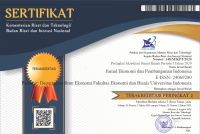Abstract
Danau Sentarum National Park (DSNP) is a conservation area which has an important role in people’s lives and society Kapuas Hulu in West Kalimantan. The objective of this study was to estimate the value of medicinal plants in the area TNDS. Contingent Valuation Method (CVM) with a single bounded was use to determine the willingness to pay for medicine plants. Data collected through direct interviews with 90 local households in DSNP using a questionnaire. Data analysis was done with MS. Excel® and SPSS® statistical software. The results show the variable value of the bid, income, age, education, and knowledge of medicinal plants significantly a ect the value of WTP. The expected WTP is found between IDR50.354,22 to IDR72.312,44 per household per month.
Bahasa Abstract
Taman Nasional Danau Sentarum (TNDS) adalah kawasan konservasi yang memiliki peran penting bagi kehidupan masyarakat di Kabupaten Kapuas Hulu dan masyarakat Provinsi Kalimantan Barat. Tujuan dari penelitian ini adalah untuk mengestimasi nilai tanaman obat yang ada di dalam kawasan TNDS. Contingent Valuation Method (CVM) dengan single bounded digunakan untuk menentukan nilai kesediaan membayar tanaman obat. Pengumpulan data dilakukan melalui wawancara langsung dengan 90 kepala keluarga di TNDS menggunakan kuesioner. Analisis data dilakukan dengan perangkat lunak MS Excel® dan SPSS®. Hasil penelitian menunjukkan variabel nilai tawaran bid, pendapatan, usia, pendidikan, dan pengetahuan mengenai tanaman obat secara signifikan memengaruhi nilai WTP. Nilai dugaan WTP adalah sebesar Rp50.354,22 sampai Rp72.312,44 per keluarga per bulan.
References
[1] Aglionby, J. C. (1995). Laporan akhir petugas asosiat professional (ekonomi lingkungan) volume 1: Perihal ekonomi di suaka margasatwa Danau Sentarum. Indonesia-United Kingdom Tropical Forest Management Programme. Pontianak.
[2] Anshari, G. Z., Anyang, Y. C. T., Kusnandar, D., Heri, V., & Jumhur, A. (2002). Taman Nasional Danau Sentarum: Lahan Basah Terunik di Dunia. Pontianak: Riak Bumi dan Yayasan Konservasi Borneo.
[3] Arrow, K., Solow, R., Portney, P. R., Leamer, E. E., Radner, R., & Schuman, H. (1993). Report of the NOAA panel on contingent valuation. Federal Register, 58(10), 4601–4614.
[4] BTNDS. (2008). Data Statistik Taman Nasional Danau Sentarum Tahun 2008. Balai Taman Nasional Danau Sentarum.
[5] Barbier, E. B., Acreman, M., & Knowler, D. (1997). Economic valuation of wetlands: a guide for policy makers and planners. Gland, Switzerland: Ramsar Convention Bureau. Diakses dari http://www.terrabrasilis.org.br/ecotecadigital/ pdf/economic-valuation-of-wetlands.pdf. Tanggal akses 28 November 2016.
[6] Cooper, J. C., Hanemann, M., & Signorello, G. (2002). Oneand- one-half-bound dichotomous choice contingent valuation. Review of Economics and Statistics, 84(4), 742–750. DOI: https://doi.org/10.1162/003465302760556549.
[7] Disnakertransos Kabupaten Kapuas Hulu. (2016). Data Demografi Kabupaten Kapuas Hulu. Dinas Tenaga Kerja, Tansmigrasi dan Sosial Kabupaten Kapuas Hulu.
[8] Fauzi, A. (2013). Valuasi Ekonomi dan Penilaian Kerusakan Sumberdaya Alam dan Lingkungan. Bogor: IPB Press.
[9] Ghozali, I. (2011). Aplikasi Multivariate dengan Program IBM SPSS 19, [Edisi 5]. Semarang: Badan Penerbit Universitas Diponegoro.
[10] Haab, T. C., & McConnell, K. E. (2002).Valuing environmental and natural resources: the econometrics of non-market valuation. Northampton, Mass., USA: Edward Elgar.
[11] Hanemann,W. M. (1994). Valuing the environment through contingent valuation. Journal of Economic Perspectives, 8(4), 19–43. DOI: 10.1257/jep.8.4.19.
[12] Herriges, J. A., & Shogren, J. F. (1996). Starting point bias in dichotomous choice valuation with follow-up questioning. Journal of Environmental Economics and Management, 30(1), 112–131. DOI: https://doi.org/10.1006/jeem.1996.0008.
[13] Hosmer, D. W., & Lemeshow, S. (2000). Applied Logistic Regression, [Second Edition]. New York: A Wiley-Interscience Publication.
[14] Kohlin, G. (2001). Contingent valuation in project planning and evaluation: the case of social forestry in Orissa, India. Environment and Development Economics, 6(2), 237–258. DOI: https://doi.org/10.1017/S1355770X01000134.
[15] Morgan, S. P., & Teachman, J. D. (1988). Logistic regression: Description, examples, and comparisons. Journal of Marriage and Family, 50(4), 929–936. DOI: 10.2307/352104.
[16] Pemerintah Desa Laut Tawang. (2015). Profil Desa Laut Tawang tahun 2014.
[17] Pemerintah Desa Leboyan. (2015). Profil Desa Leboyan Tahun 2014.
[18] Pemerintah Desa Pulau Majang. (2015). Profil Desa Pulau Majang Tahun 2014.
[19] UN. (1992). Convention on Biological Diversity. United Nations. Diakses dari https://www.cbd.int/doc/legal/cbd-en. pdf. Tanggal akses 1 Desember 2016.
[20] UNEP. (2015). United Nations Environment Programme Annual Report 2015. United Nation Environment Programme. Diakses dari http://web.unep.org/annualreport/2015/en/index. html. Tanggal akses 4 Desember 2016.
[21] Wadley, R. L., & Colfer, C. J. P. (2004). Sacred forest, hunting, and conservation in West Kalimantan, Indonesia. Human Ecology, 32(3), 313–338. DOI: https: //doi.org/10.1023/B:HUEC.0000028084.30742.d0.
[22] Whitehead, J. C. (2002). Incentive incompatibility and starting-point bias in iterative valuation questions. Land Economics, 78(2), 285–297. DOI: 10.2307/3147274.
[23] Yi, Y., & Wang, X. (2011). Comparison of Wald, score, and likelihood ratio tests for response adaptive designs. Journal of Statistical Theory and Applications, 10(4), 553–569.
[24] Yuliani, E. L., & Erman, A. (2005). Present trends of resource us in Danau Sentarum National Park. Paper presented at the Heart of Borneo Conference, Leiden, 25–28 April 2005.
Recommended Citation
Ginting, Thasia; Ismail, Ahyar; and Simangunsong, Bintang
(2017)
"Nilai Ekonomi Tanaman Obat di Taman Nasional Danau Sentarum, Kalimantan Barat,"
Jurnal Ekonomi dan Pembangunan Indonesia: Vol. 18:
No.
1, Article 2.
DOI: 10.21002/jepi.2018.02
Available at:
https://scholarhub.ui.ac.id/jepi/vol18/iss1/2








